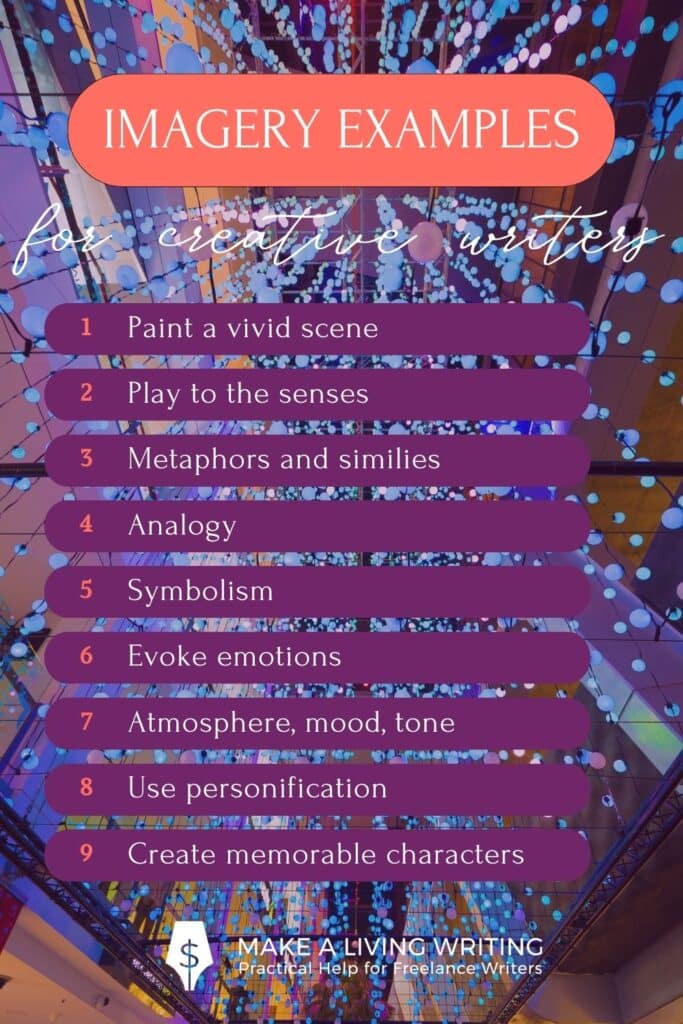Imagery is figurative language that activates the reader’s imagination to create a clear mental picture, convey tone, and elicit emotion. You can find imagery examples everywhere. From centuries-old Charles Dickens novels and Shakespearian plays to modern-day blogs and advertisements, imagery remains one of the most commonly used writing techniques.
In this article, we will explore examples of imagery in film and literature, practical tips, and techniques to help you bring your writing to life.

9 imagery examples for writers
For any writer, imagery is an important tool to pull out of your box of tricks to elevate your work. Here are nine imagery examples to get you started.
Paint a vivid scene
Creating scenery in the readers’ mind is an essential aspect of writing. When readers can clearly picture the scene in their mind, they are much more likely to remember the story and take away the message whether that be a theme or a call to action.
To boost your scene descriptions, try incorporating more adjectives, or as I like to call them “juicy words.”
Instead of saying, “The sun was setting” you might say, “The coral sky was ablaze as the golden sun dipped below the horizon, casting long, smokey shadows of jagged mountains across the tranquil valley.”
Play to the senses
Another way to get your words to jump off the page is to engage the five senses. Using sensory language such as visual, auditory, olfactory, tactile, and gustatory imagery adds new layers that together helps to create an immersive experience for the reader.
Visual imagery (sight)
Her long golden hair was draped over her shoulder and tied with a black velvet ribbon.
Auditory imagery (sound)
The light spring rain fell in a melodic rhythm on the flimsy tin roof of the dilapidated chicken coop.
Olfactory imagery (smell)
Entering the bakery, my senses are bombarded with swirling scents of freshly baked bread, vanilla icing, and fruity pastries.
Tactile imagery (touch)
I felt alive, squishing soft warm sand between my wet toes as I ran up the beach.
Gustatory imagery (taste)
Bitter dark chocolate with bursts of crunchy sea salt and silky caramel.
Metaphors and similes
Metaphors and similes can be used to make both literal and figurative comparisons memorabe. A simile makes a comparison using “like” or “as,” whereas a metaphor makes a direct comparison between unrelated things without “like” or “as.”
Metaphor examples
- Her presence is a ray of sunshine
- He has a heart of gold
- His anger is a raging fire
- I have found her, she’s an angel
Simile examples
- Her room was so messy it smelled like something had died in there
- He ran as fast as a cheetah
- My heart beat like a drum
- The dancer leapt like a gazelle, as light as a feather
Analogy
A good analogy can help a reader visualize and understand an abstract idea. Similar to metaphors and similes, analogies allow us to explain a difficult concept by comparing it to something familiar and simpler.
For example,
- The famous Forrest Gump quote “Life is like a box of chocolates, you never know what you are going to get” is a commentary on the unpredictability of life (this is also an example of simile)
- In The Wizard of Oz, Dorothy’s journey to the Emerald City is an analogy for self-discovery
- The Phantom’s mask in The Phantom of the Opera is an analogous symbol for the metaphorical masks that people wear to hide their true selves
- The chaos of a sinking ship in The Titanic is an analogy to society’s class system, demonstrating how everyone is equal in the face of disaster
Symbolism
Symbolism or symbolic imagery can communicate powerful messages and themes in subtle but impactful ways.
Often what hallmarks a piece as a classic is its deep and complex symbolism. There are many common symbols you can use as recurring motifs to enrich your writing, such as owls (intellect/wisdom), doves (peace), roses or hearts (love/romance), and sunflowers (happiness).
Here are a few more examples.
- The raven in Edgar Allan Poe’s The Raven represents many things including loss, bad omen, prophecy, and insight
- The green light in The Great Gatsby by F. Scott Fitzgerald symbolizes Gatsby’s unwavering love for Daisy
- The Ferris wheel in Tuck Everlasting by Natalie Babbitt represents the passage of time happening around the Tucks while they remain stagnant at the center
Evoke emotions
Good examples of imagery both bring out the emotions of the characters and of the reader. Organic imagery is when a writer describes a character’s mental or emotional state.
For example, “her heart fluttered as her cheeks blushed a vibrant shade of pink” or, “he fell to his knees from the overwhelming pang of grief realizing he would never see her again.”
An in-depth description of an emotional event or character’s mindset can help the reader relate to those feelings and put themselves in the story, eliciting an emotional reaction.
Atmosphere, mood, and tone
Imagery plays a pivotal role in setting the atmosphere, mood, and tone of a piece of writing.
An author can emphasize friendship by using imagery of togetherness to evoke feelings of joy and belonging, bringing a light, happy tone to the story.
A piece can take on a negative tone of pain and sadness with imagery of isolation and despair to emphasize loss.
Examples of stories with a dark tone:
- Dracula by Bram Stoker
- Frankenstein by Mary Shelley
- The Raven by Edgar Allan Poe
Examples of stories with a feel-good, light tone:
- Anne of Green Gables by L.M Montgomery
- Pride and Prejudice by Jane Austin
- Little Women by Louisa May Alcott
Use personification
Personification is a great example of how imagery can breathe life into your writing. Giving human characteristics to an object, animal, or even phenomena helps authors add personality and depth to their descriptions.
Personification is a technique that helps readers connect with a piece where it makes the author’s words more engaging, relatable, and memorable.
For example:
- Opportunity came knocking on his door
- The wind whispered its secrets across the valley
- The blooming flowers woke up to say good morning
- The car gave a protesting groan asking to be taken back to the garage
- If these walls could talk they would have a lot to say
Create memorable characters
Authors who use imagery well have the remarkable ability to bring their characters to life. With vivid descriptions of their character’s appearance, mannerisms, inner thoughts, and personality traits, writers can make readers see themselves or people they know in the characters.
Appearance
Instead of “He’s a nice-looking man,” try, “His piercing blue eyes sparkled like sapphires against the backdrop of his flawless olive skin.”
Mannerisms
Instead of “She was nervous,” try, “She compulsively tapped her fingers on the desk, bit her lip, and darted her eyes back and forth.”
Inner thoughts
Instead of “He was sad,” try, “A dark cloud hung over his head and he felt an immovable weight settle on his chest.”
Personality traits
Instead of “She was kind,” try, “Her warm smile and laughter always felt like the clouds had parted to let the sun shine through.”
Writers are artists who paint mental images in the minds of readers using their words. Choosing those words wisely makes all the difference in making characters, settings, and ideas memorable and relatable to audiences.
From metaphors to personification to setting the mood, imagery examples can be found woven throughout all types of writing. So whether you are a copywriter, creative writer, or blogger looking for ways to elevate your craft, play around with imagery and see your words come alive.










